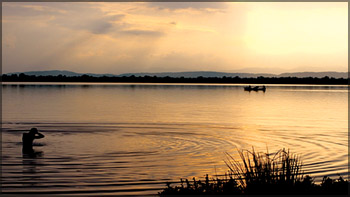|
 Parakrama
Samudraya: Parakrama
Samudraya:
The sea of Polonnaruwa
When
you visit Polonnaruwa or when the topic Polonnaruwa comes up, one of the
main things that won't escape your attention is the Parakrama Samudraya.
A popular slogan of King Parakramabahu I was "Don't let even a drop of
water go to the sea without making use of it". That is why he took so
much interest in building tanks.
Parakrama Samudraya, the vast water reservoir, was built by King
Parakramabahu I (1153-1186) and what you see today as the Parakrama Samudraya is only a portion of his
original creation. It is of such width that it is impossible to stand
upon one shore and view the other side.
you see today as the Parakrama Samudraya is only a portion of his
original creation. It is of such width that it is impossible to stand
upon one shore and view the other side.
It encircles the main city like a ribbon, being both a defensive
border against invaders and the lifeline of the people in times of
peace. Now can you imagine how it must have been those days? No wonder
it was named 'Samudraya' (the sea)!
This is the largest irrigation tank built by King Parakramabahu I. It
was the life-blood of the ancient city, providing water for the growth
of thirsty rice crops and other food crops.
It is said that one thousand men were employed in the labour process
during the constrcution of the tank, working 24 hours a day. This could
scarcely have completed the job in 12 years. They used stone blocks,
each weighing over ten tons, to build a 12-metre high and 12-km long
embankment(a raised area to keep back water).
The sluice (the gate to control the water flow) alone was 100 cubits
(over 60 feet) high. Parakrama Samudraya held 5,600 acres of water,
which irrigated 18,200 acres of paddy fields.
A beautiful, three-storey royal palace was built in an island in the
middle of the reservoir. A dagoba was also built on the rock adjoining
the reservoir. Parakrama Samudraya originally consisted of five large
reservoirs separated by smaller dams to reduce the pressure on the main
dam.
Many smaller tanks had been built around the main tank to feed these
primary tanks and to remove excess water. The five main reservoirs,
which comprise the Parakrama Samudraya, were Thopa Weva, Eramudu Weva (Katu
Weva), Dumbuthulu Weva, Kalahagala Weva and Bhu Weva.
During the reconstruction of Parakrama Samudraya, the water, which
was supposed to flow to the Thopa Weva, started flowing to the Bhu Weva
instead. Then the engineers constructed a temporary dam to block the
water flowing to the latter.
This temporary wall later became a permanent road which isolated
Kalahagala Weva and Bhu Weva from the Parakrama Samudraya. The new
reconstruction process has ignored most of the ancient technology, with
the tank also being reduced in capacity.
 As
at today, the dam of Parakrama Samudraya is eight and a half miles (14
kilometres) in length and 40 feet (12.2 metres) in height. The body of
water covers 5,350 acres with an average depth of 25 feet. As
at today, the dam of Parakrama Samudraya is eight and a half miles (14
kilometres) in length and 40 feet (12.2 metres) in height. The body of
water covers 5,350 acres with an average depth of 25 feet.
Over 18,000 acres of paddy land is supported by this reservoir. On
one edge of the reservoir is the Polonnaruwa Rest House which is managed
by the Ceylon Hotels Corporation. Along the dam, there are a few star
class hotels, closer to the Pothgul Vehera.
After travelling to the very end of the dam (all eight and a half
miles) and further along the canal which feed the Parakrama Samudraya,
one arrives upon a place called 'Angammadilla'.
This is the place where the Amban Ganga (river) is diverted towards
the Parakrama Samudraya. After walking about 500 metres in to the
jungle, one comes to a still unspoilt camping and bathing site. Due to
the distance from the main city, this location is still untouched and is
a great place to spend the day.
This area is elephant country and the dung of wild elephants can be
seen as one walks along the path to the river. A little scary if you try
it when it is dark!
Janani Amarasekara |
